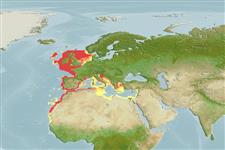Common names from other countries
Environment: milieu / climate zone / depth range / distribution range
Ecología
marino demersal; rango de profundidad 20 - 400 m (Ref. 35388). Subtropical; 60°N - 15°N, 18°W - 36°E
Northeast Atlantic: British Isles south to Senegal (baie du Lévrier) and the Mediterranean.
Length at first maturity / Tamaño / Peso / Age
Maturity: Lm ?, range 14 - ? cm
Max length : 35.0 cm SL macho / no sexado; (Ref. 35388); common length : 14.0 cm TL macho / no sexado; (Ref. 3397); edad máxima reportada: 14 años (Ref. 32766)
Espinas dorsales (total) : 0; Radios blandos dorsales (total) : 0. Upper eye less than its own diameter from dorsal profile of head. Anterior nostril on blind side not enlarged, its distance from front margin of head about twice in its distance from cleft of mouth. Anterior nostril on eyed side with backward-pointing tube reaching to front border of lower eye. Pectoral fin on eyed-side small, on blind side reduced.
Inhabits mud or sand bottoms. Feeds on a wide range of small bottom-living organisms, mainly crustaceans (amphipods, shrimps), also polychaete worms and bivalve mollusks (Ref. 4710). Utilized as a food fish.
Robins, C.R., R.M. Bailey, C.E. Bond, J.R. Brooker, E.A. Lachner, R.N. Lea and W.B. Scott, 1991. World fishes important to North Americans. Exclusive of species from the continental waters of the United States and Canada. Am. Fish. Soc. Spec. Publ. (21):243 p. (Ref. 4537)
IUCN Red List Status (Ref. 130435)
CITES (Ref. 128078)
Not Evaluated
Threat to humans
Harmless
Human uses
Pesquerías: comercial
Herramientas
Special reports
Download XML
Fuentes de Internet
Estimates based on models
Preferred temperature (Ref.
115969): 7 - 16, mean 10.3 (based on 434 cells).
Phylogenetic diversity index (Ref.
82804): PD
50 = 0.5078 [Uniqueness, from 0.5 = low to 2.0 = high].
Bayesian length-weight: a=0.00813 (0.00655 - 0.01008), b=3.05 (3.01 - 3.09), in cm Total Length, based on LWR estimates for this species (Ref.
93245).
Nivel trófico (Ref.
69278): 3.3 ±0.45 se; based on food items.
Resiliencia (Ref.
120179): Medio, población duplicada en un tiempo mínimo de 1.4-4.4 años (K=0.37; tm=3; tmax=14).
Fishing Vulnerability (Ref.
59153): Moderate vulnerability (44 of 100).
Climate Vulnerability (Ref.
125649): Low vulnerability (9 of 100).
